Publishers can take the lead in solving misinformation. In fact misinformation has been a focal point of many recent research reports in the publishing industry. Since the start of 2021, we have seen Trusted Web publish their report on the State of Misinformation and Reuters released their Listening to What Trust in News Means to Users: Qualitative Evidence from Four Countries to name but a few.
The &and Leuven festival hosted last month also covered topic of misinformation. Alongside Wikipedia founder Jimmy Wales and KU Leuven Professor Peggy Valke, Twipe’s Dana Nastase tried to answer the question “Is the truth still true?”.
Traditional media: Guardians of the truth?
Through decades of reporting trusted news to citizens, traditional news organisations are the pioneers of precision and guardians of the truth. In fact, over the course of 2020 with the COVID-19 pandemic, news organisations broke digital subscription records. When faced with a global pandemic, people wanted news that they could trust. This new high for newspaper subscriptions showed a willingness of people to pay for trustworthy news. Positively for the industry, this is a trend that publishers predict will continue on their digital platforms over the coming years.
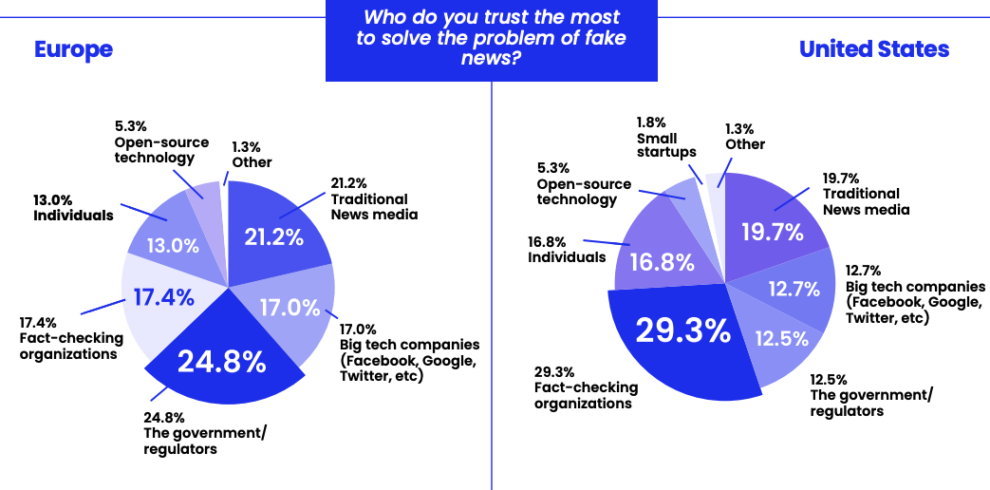
Trusted Web’s Misinformation report supports this trust in traditional media. Respondents selected who they trusted most to solve the problem of misinformation and fake news. Interestingly, in both the USA and Europe around 20 % of respondents trust traditional media the most to solve the problem of misinformation. This ranks second, closely behind governments in Europe and fact-checking organisations in the USA.
This trust in traditional media is highly relevant because they have the education, expertise and motivation to do this. Equipped with the right technologies and tools and sustained by the right business models, publishers could indeed be best placed to be guardians of the truth.
More education needed to spot fake news
Spotting fake news is sometimes a difficult task. With the sheer amount of news, both real and fake, circulating in the digital world, readers often struggle to differentiate between the two. This can explain why newspapers remain widely read despite the ongoing talk surrounding the declining importance of print.
Educating readers on how to spot fake news therefore is an important topic, but a challenging one. Reuters worryingly found that:
“For those who set out to verify information, seeing the same story repeated by multiple sources when they searched online often served as sufficient evidence for believing a given story was accurate”.
Reuters
This practise of taking multiple sources reporting a story as fact is problematic and incorrect. The internet can be a political echo chamber, especially with the rise of filter bubbles from AI. It can therefore resultantly give rise to fake news through fake verification. Worryingly, consumers are too confident in their ability to spot fake news.
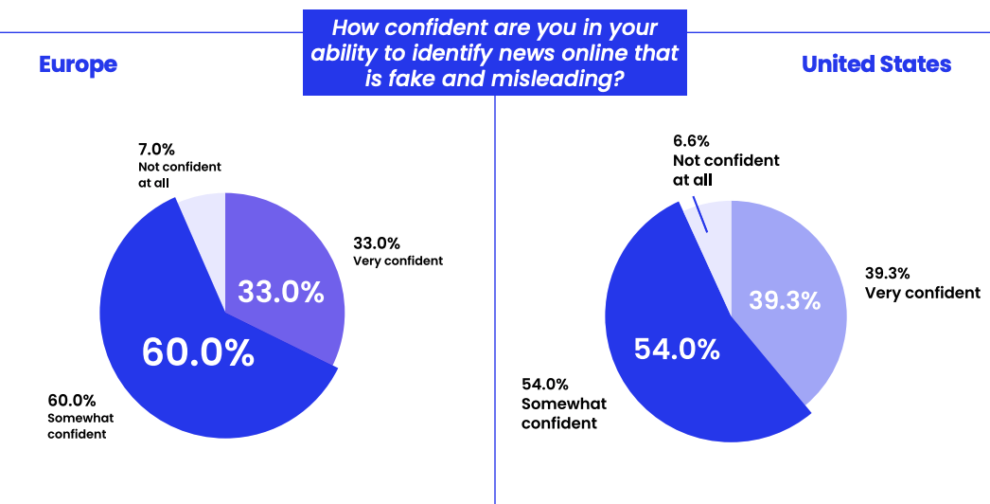
Trusted Web found that confidence in spotting fake and misleading news is still relatively high across Europe and the US. With more than 90% of respondents being somewhat or very confident that they can spot fake news, it is surprising to see that 35-38% of people still believe that they have shared misleading or false content.
It is easy to mirror verified publisher accounts. Through these fake accounts, it is easy to provide misleading news.
“…If you just give it a glance you’d think that, ‘Oh, that’s a verified account’, and then if you actually look at it again…it’s actually not…”
Antoine, Reuters
Misinformation in the mainstream
Unfortunately, misleading news may be present even in news organisations driven by click based business models. At the &and Leuven festival, Wikipedia Co-Founder Jimmy Wales cited a story from 2014. The story was about China “starting to televise the sunrise on giant TV screens because Beijing is so clouded in smog”.

This was however a fake story as in fact the screens are just billboards advertising holidays to Shandong, another province in China. The picture created a story. Despite its’ fake nature, it is still live on the website today. This type of misinformation can make it more difficult for readers to spot fake news.
While awareness on misinformation has evolved both among news organisation and readers since 2014, more education is needed. Initiatives like the Media Literacy campaigns in Belgium, the GNI funded Battling Misinformation initiative, the EU co-funded Trusted Web and FactCheck.org are great to see.
Trust in Traditional Media on the rise
Despite this, trust in news media is increasing. Edelman’s trust barometer found that trust in the media, although relatively low on average, has increased over the past year.
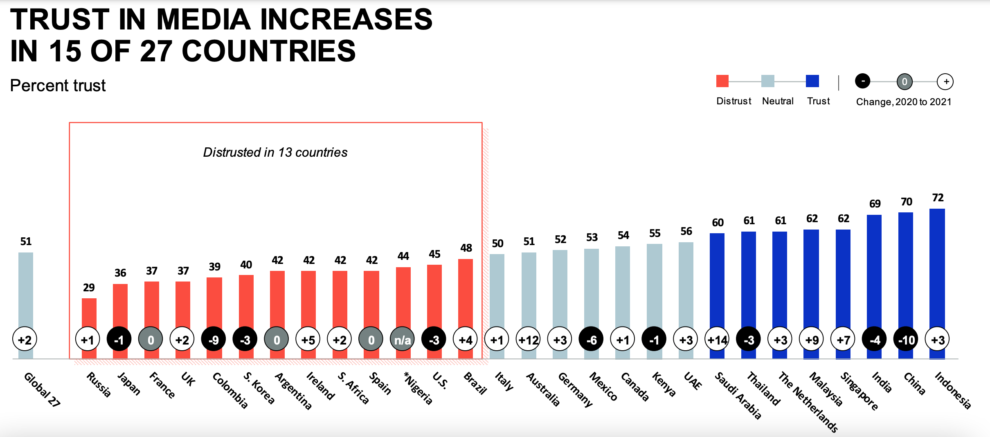
This increase has particularly been present in Europe and other western nations. Further hope for the industry can be seen where people trust their news to come from. National news is believed to be more trustworthy than local news in Europe. In the US, however, people have greater trust in local news.
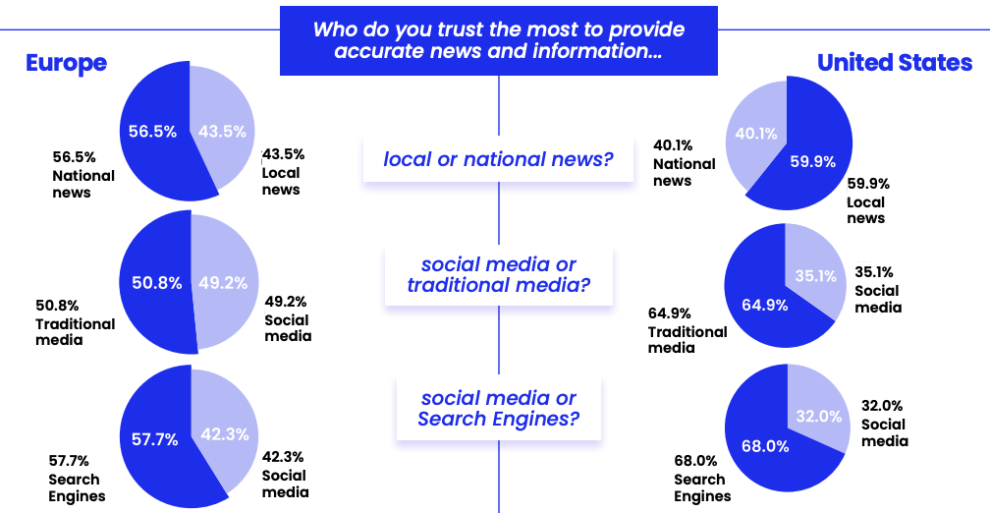
Reuters found that trust in local news is often higher as people feel they can verify the facts. Actions taking place on a local level can be verified in daily life more than national actions. What is also encouraging to see from Trusted Web’s findings is that traditional media seems to have greater trust to provide accurate news than social media.
Fake news vs. Freedom of Speech
Ways of dealing with fake news is a controversial topic. Whilst posting fake news is ethically wrong and can be seen to be pursuing certain agendas, it is not illegal.
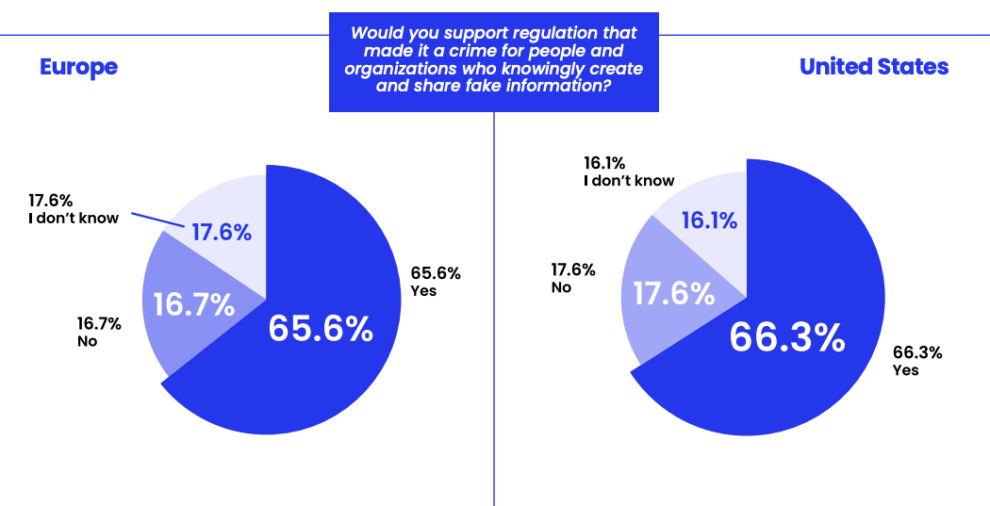
In a stat that particularly shocked me, around 66% of people in both the USA and Europe believe that legislation criminalising fake news is the answer. This would certainly help to discourage people from posting fake news, but sets a dangerous precedent around limiting freedom of speech. Professor Peggy Valke echoed this sentiment at &and Leuven. Valke argued that:
“If you talk about regulating fake news you talk about regulating free speech and that’s a very slippery slope”.
Professor Peggy Valke, KU Leuven
There are also many issues with creating a law on banning fake news. For example, who would we choose to determine what is true and how do you define fake news? Other less controversial methods could limit fake news from spreading.

For example Trusted Web found 50% of Europeans and 53.4% of Americans were in favour of limiting the reach of content that not published by an organisation or author. Whilst this could limit the reach of news deemed as misleading or untrustworthy, it also still lets it be present. This is far more favourable. It does not edge as close to the border of limiting free speech. Instead, it gives a specific area for fake news to be hidden from the untrained eye.
Traditional media have the tools and education to take the lead in solving misinformation. In order to grasp this opportunity, they need the right business models and technologies to do this. At Twipe, we believe that editions based products can be the best solutions for this. Through editorial curation and journalistic insight in these editions, publishers can remain guardians of the truth.
